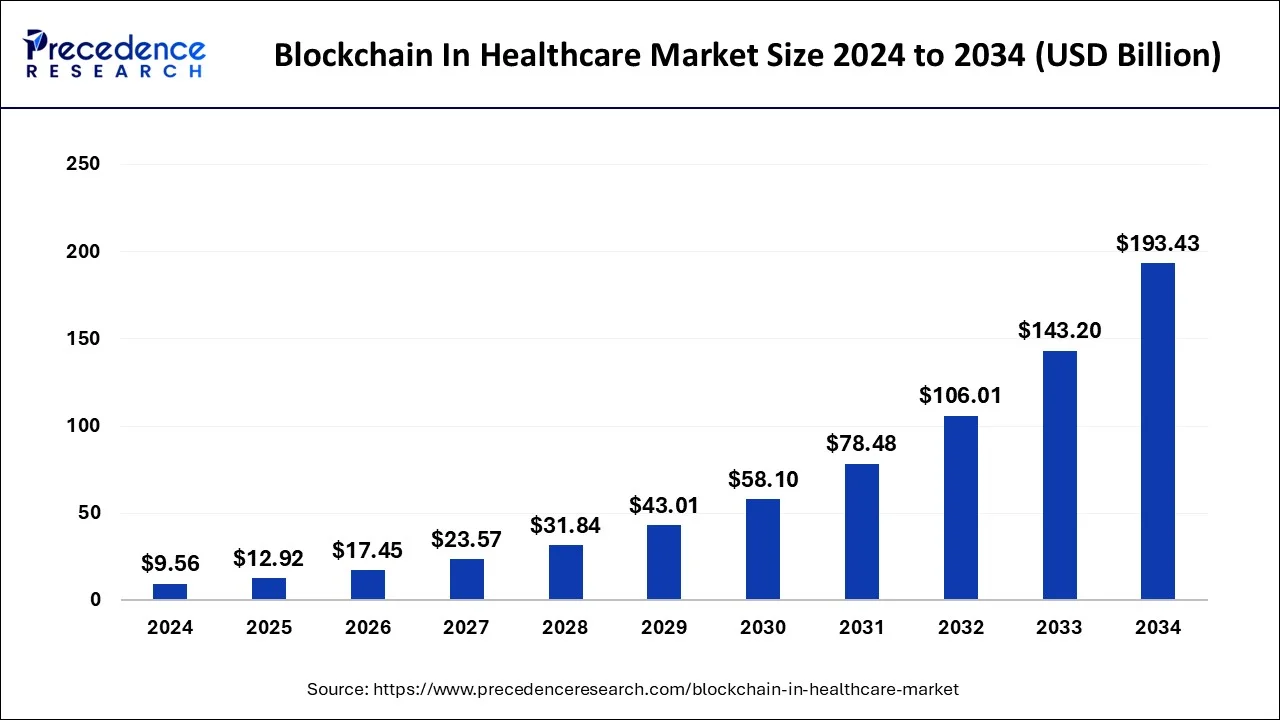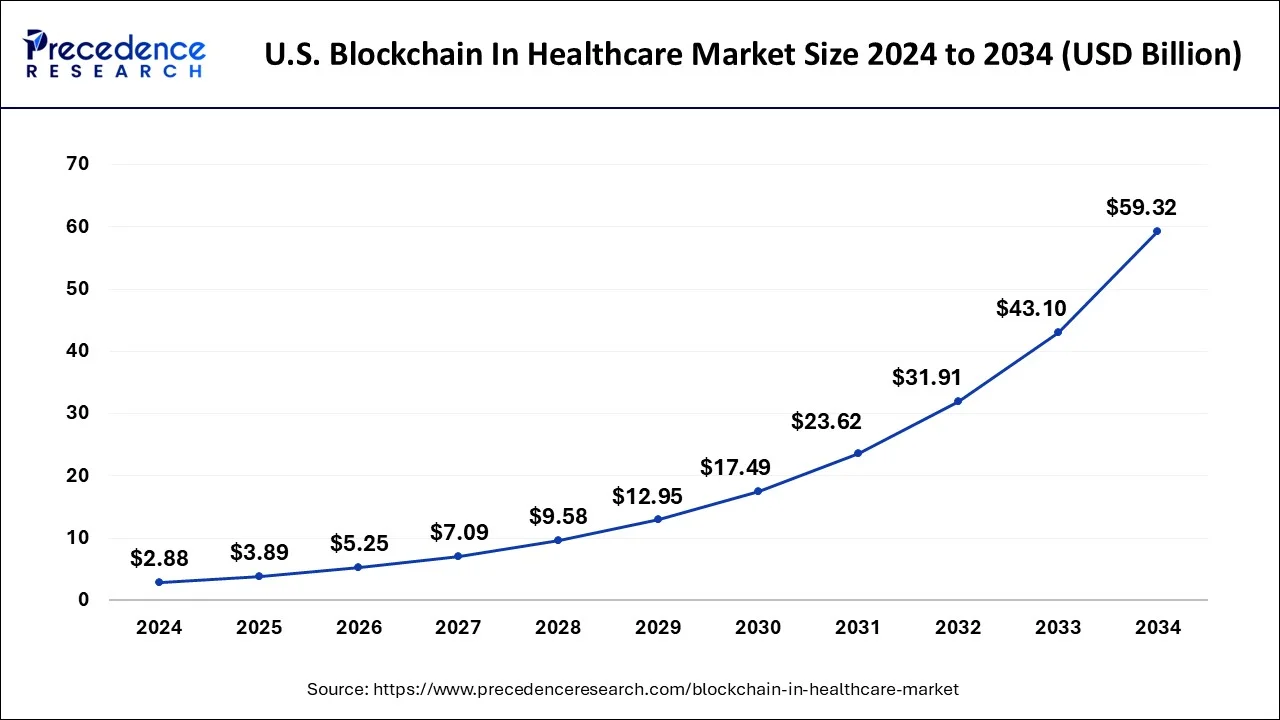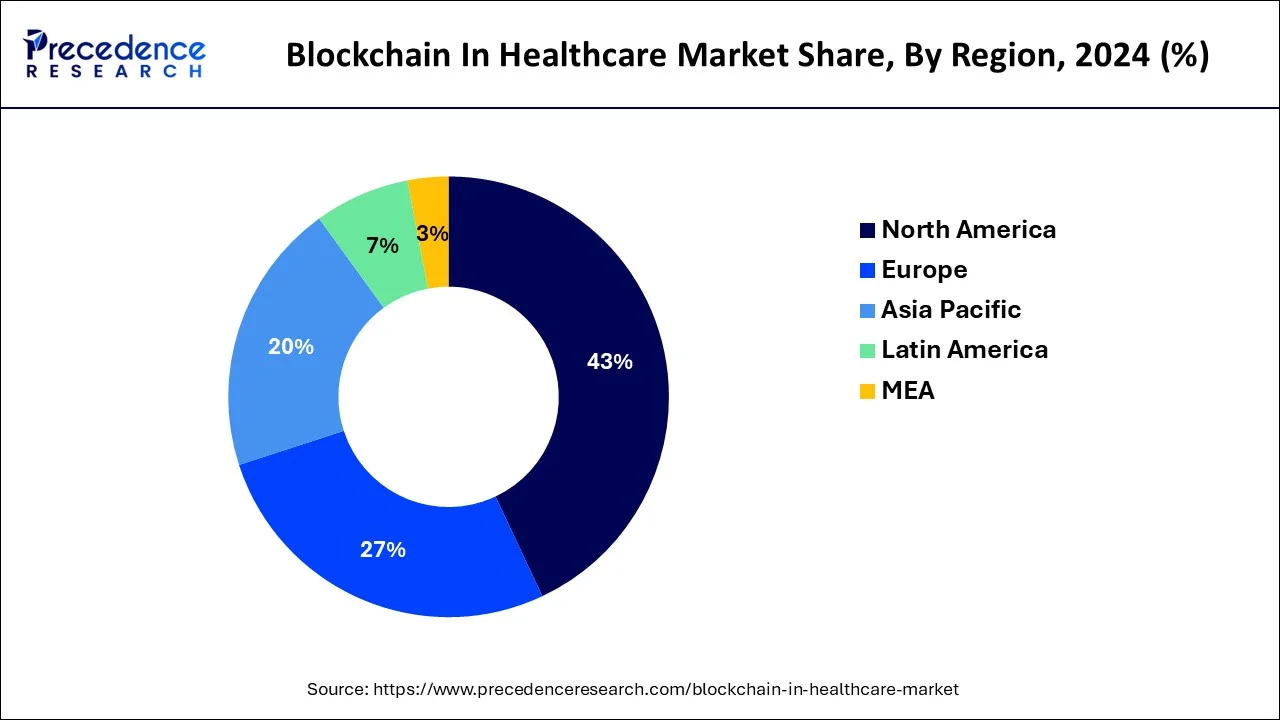May 2025
The global blockchain in healthcare market size was accounted for USD 9.56 billion in 2024 and is anticipated to reach around USD 193.43 billion by 2034, growing at a CAGR of 35.08% from 2025 to 2034. The rising adoption of the digitization across the healthcare industry and the demand for the efficient medical data storage system or technology is driving the growth of the market.

The integration of AI into healthcare is revolutionalize the overall healthcare applications. The AI and blockchain are one of the revolutionary technologies which are associated with the healthcare industry. while the blockchain used to store and manage all the clinical or healthcare data and the integrated AI technology enhance the decision making process for analysis of large quantity of data. The integration of AI into the healthcare enhance the efficiency of the healthcare applications.
For Instance,
The U.S. blockchain in healthcare market size was evaluated at USD 2.88 billion in 2024 and is predicted to be worth around USD 59.32 billion by 2034, rising at a CAGR of 35.33% from 2025 to 2034.

North America dominated the blockchain in healthcare market with revenue share of 43% in 2024. The growth of the market is attributed to the regional countries are the early adopter of technologies in every field of industries. The increasing evaluation of the healthcare sector and the integration of modernization with technological association such as blockchain, automation, artificial intelligence, and other for improving the overall operational efficiency of the industry is driving the growth of the market. Additionally, the rising investment on the technological development and the continuous research and development program on the expanding healthcare efficiencies are collectively driving the growth of the blockchain in healthcare market in the region.
For Instance,

Europe held a notable share in the market in 2024. The European countries are one of the significant contributors on the expansion of the healthcare technologies. The region is widely accepted the blockchain in healthcare for maintaining and managing the data storage and supply with the transparency and traceability which contribute in the growth of the blockchain in healthcare market in the region.
Asia Pacific expects significant growth in the market during the forecast period. The growth of the market is attributed due the continuous rise in the population and the demand for the healthcare sector with more efficiency and transparency is driving the demand for the blockchain into the healthcare sector. The increasing investment by the leading market players and the government agencies on the expansion of healthcare sector with integrating smart technologies are accelerating the growth of the blockchain in healthcare market across the region.
For Instance,
The blockchain is one of the efficient technology that used in the healthcare industry in the wide range of applications including clinical trial, enhancing safety, patient monitoring, display information and transparency. Blockchain in healthcare effectively manages the financial and clinical data of patient and reduce the cost and time of the data storage and transformation. The blockchain is used to do complex coding for every individuals medical data to prevent sensitive information and data leakage. The increasing automation and digitization across the healthcare sector for increasing the operational output is driving the growth of the market.
| Report Coverage | Details |
| Market Size in 2025 | USD 12.92 Billion |
| Market Size by 2034 | USD 193.43 Billion |
| Growth Rate from 2025 to 2034 | CAGR of 35.08% |
| Base Year | 2024 |
| Forecast Period | 2025 to 2034 |
| Largest Market | North America |
| Segments Covered | By Network Type, By Application, By End-User |
| Regions Covered | North America, Europe, Asia-Pacific, Latin America, Middle East & Africa |
The integration of blockchain helps in enhancing healthcare operations
The adaptation of technologies into the healthcare operations or applications for enhancing its efficiency is driving the growth of the market. blockchain is uses in the wide range of healthcare applications such as patient data management, store clinical trail, pharmaceutical supply chain, telemedicine and remote monitoring, interoperable health data exchange, healthcare payments, and tracking doctors and health workers credentials. The blockchain enhance the cost efficiency, increase data security, enhance transparency, and efficient claim processing that enhance overall profitability and growth of the healthcare industry.
High cost
The high cost associated with the use of this technology in the healthcare sector is the major factor hampering the market growth. This high cost is due to various factors such as regulatory complexities, development expenses, and the requirement for specialized expertise. However, blockchain's encrypted and decentralized nature is convenient for healthcare data security, but securing data requires extensive investment, which can be challenging.
Enhancing investment in healthcare technologies
The growing healthcare industry owing to the increasing prevalence of the chronic disease in the population and the demand for the technological integration in clinical application is driving the larger investment by the stakeholders or the government agencies. Furthermore, the rising research and development program in the technological advancements and emerging healthcare technologies are emerging as the potential opportunity for the market.
The public segment dominated the blockchain in healthcare market in 2024. The rising deployment of the public blockchain in healthcare owing to its transparency and these type of network allows access information such as supply chain management, patient records, medical data to all the participants. The increasing demand for the healthcare data security, enhance transparency and traceabilty, efficient supply chain management is driving the demand for the public network blockchain technology in healthcare.
The private segment expects significant growth in the market during the forecast period. the increasing adoption of the private network due to its enhance safety features and properties that makes its ideal for preventing the sensitive clinical information of patients. The private blockchain limits the accessibility of the authorized participants only. These network restraint the data breaches and unauthorized access. Private blockchain also benefits in the applications like immutable and auditable records, secure data sharing, consent management, smart contracts for compliance automation, and data integrity and non-repudiation.
The supply chain management segment led the blockchain in healthcare market in 2024. The blockchain technology is efficiently helps in managing all the information in the healthcare supply chain by increasing interoperability, security, and data integrity. In the supply chain management application blockchain provides the continuous audit to timely actions. It enables real-time availability for the better communication.
The data exchange and interoperability segment accounted for the substantial growth in the blockchain in healthcare market during the predicted period. the increasing use of blockchain in the healthcare data and exchange due to its seamless transfer of assets and data. The blockchain interoperability is used to interact of connect different blockchain systems, conduct transaction, and share information with one another in healthcare. It provides the several benefits to the such as enhance functionality, flexibility, and increase the adaptation of blockchain technology.
The pharmaceutical & medical device companies segment accounted for the largest share in 2024. The adaptation of the blockchain into the pharmaceutical industry aims to increase transparency and traceability within industry. The integration of blockchain into the pharmaceutical industry is transforming the supply chain management, patient safety, and data integrity. It improves the quality management of the clinical data with association with different features such as decentralization, immutability, smart contracts, transparency, traceability, and data security. The blockchain enhance the transparency and traceability in operations which enhance patient safety, counterfeit drug mitigation, regularity compliance, data integrity, and quality assurance.
For Instance,
The healthcare payers segment expecting a significant growth in the blockchain in healthcare market during the forecast period. The healthcare payers includes the different agencies or institutes such as government agencies, and insaurance companies. There are the large number of healthcare payers are adopting the blockchain technology for enhancing trasperancy, maintaining operations, and minimize the risk of fraud. The rising investment in the latest technologies by the leading healthcare payers and the digitization and automation across the healthcare operations are driving the expansion of the blockchain technology in healthcare industry.
In March 2025, China opened the world's first AI hospital equipped with 14 artificial intelligence doctors, marking a significant milestone in healthcare technology. This development is likely to boost interest in healthcare-related blockchain and AI crypto projects, as traders may anticipate increased adoption of decentralized medical data solutions and tokenized AI healthcare platforms.
In April 2025, ChatGPT Edu will be available to every medical and graduate student at Icahn Mount Sinai. This development signals increased adoption of advanced AI tools in the healthcare and education sectors, which could accelerate blockchain integration for secure data management and compliance in medical research. This development, while primarily focused on educational applications, has potential effects on the cryptocurrency markets.
In October 2023, Solve. Care collaborated with Binance to expand the integration of cryptocurrency in the healthcare sector. The connection broadens the applications for cryptocurrencies, which makes it easier and more convenient to use them to pay for healthcare services.
Network Type Insights
Application Insights
End-User Insights
Regional Insights
For inquiries regarding discounts, bulk purchases, or customization requests, please contact us at sales@precedenceresearch.com
No cookie-cutter, only authentic analysis – take the 1st step to become a Precedence Research client
May 2025
September 2024
June 2025
August 2025